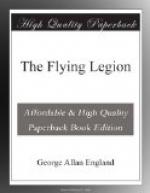Through the westward windows, umbers and pearls of dying day, smudged across a smoky sky, now shadowed trophy-covered walls. This light, subdued and somber though it was, slowly fading, verging toward a night of May, disclosed unusual furnishings. It showed a heavy black table of some rare Oriental wood elaborately carved and inlaid with still rarer woods; a table covered with a prayer-rug, on which lay various books on aeronautics and kindred sciences, jostling works on Eastern travel, on theosophy, mysticism, exploration.
Maps and atlases added their note of research. At one end of the table stood a bronze faun’s head with open lips, with hand cupped at listening ear. Surely that head must have come from some buried art-find of the very long ago. The faint greenish patina that covered it could have been painted only by the hand of the greatest artist of them all, Time.
A book-case occupied the northern space, between the windows. It, too, was crammed with scientific reports, oddments of out-of-the-way lore, and travels. But here a profusion of war-books and official documents showed another bent of the owner’s mind. Over the book-case hung two German gasmasks. They seemed, in the half-dusk, to glower down through their round, empty eyeholes like sinister devil-fish awaiting prey.
The masks were flanked by rifles, bayonets, knives, maces, all bearing scars of battle. Above them, three fragments of Prussian battle-flags formed a kind of frieze, their color softened by the fading sunset, even as the fading of the dream of imperial glory had dulled and dimmed all that for which they had stood.
The southern wall of that strange room—that quiet room to which only a far, vague murmur of the city’s life whispered up, with faint blurs of steamer-whistles from the river—bore Turkish spoils of battle. Here hung more rifles, there a Kurdish yataghan with two hand-grenades from Gallipoli, and a blood-red banner with a crescent and one star worked in gold thread. Aviator’s gauntlets draped the staff of the banner.
Along the eastern side of this eyrie a broad divan invited one to rest. Over it were suspended Austrian and Bulgarian captures—a lance with a blood-stiffened pennant, a cuirass, entrenching tools, a steel helmet with an eloquent bullet-hole through the crown. Some few framed portraits of noted “aces” hung here and elsewhere, with two or three photographs of battle-planes. Three of the portraits were framed in symbolic black. Part of a smashed Taube propeller hung near.
As for the western side of Niss’rosh, this space between the two broad windows that looked out over the light-spangled city, the Hudson and the Palisades, was occupied by a magnificent Mercator’s Projection of the world. This projection was heavily annotated with scores of comments penciled by a firm, virile hand. Lesser spaces were occupied by maps of the campaigns in Mesopotamia and the Holy Land. One map, larger than any save the Mercator, showed the Arabian Peninsula. A bold question-mark had been impatiently flung into the great, blank stretch of the interior; a question-mark eager, impatient, challenging.




